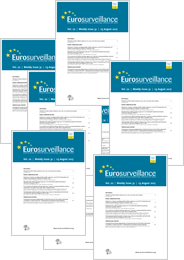- Home
- Weekly releases (1997–2007)
- Previous Issues
- Volume 6, Issue 44, 31/Oct/2002
Weekly releases (1997–2007) - Volume 6, Issue 44, 31 October 2002
Volume 6, Issue 44, 2002
- Articles
-
-
-
Cluster of wound botulism cases in injecting drug users in England (*see footnote)
More LessSix cases of wound botulism in injecting drug users (IDUs) have been reported by the Public Health Laboratory Service Food Safety Microbiology Laboratory (PHLS FSML) in London since 1 August 2002 (1). This brings the total number of clinically diagnosed cases of wound botulism in IDUs reported in the United Kingdom and Republic of Ireland to 13 in 2002 (2, 3). The recent cases may be caused by a batch of drugs contaminated with the anaerobic bacterium Clostridium botulinum. Reports of wound botulism in IDUs are a relatively new phenomenon with no clinically diagnosed cases in the UK and Republic of Ireland up to the end of 1999. There were, however, six reports in 2000 and four in 2001 (4 and references therein, 5 and references therein).
-
-
-
HUS due to a sorbitol-fermenting verotoxigenic E. coli O157 in Scotland
More LessThe Scottish Escherichia coli O157 Reference Laboratory (SERL) has reported the isolation of a sorbitol-fermenting verotoxigenic E. coli (VTEC) O157 strain from a 5 year old child with haemolytic uraemic syndrome (HUS) (1). No source of infection has yet been identified.
-
-
-
Low incidence of Creutzfeldt-Jakob disease in Europe
A Molesworth , L Pritchard and H WardMore LessA recent article on the incidence of Creutzfeldt-Jakob disease (CJD) in Germany shows consistently low rates of disease between 1994 and 2001, at less than one case per million inhabitants (1). CJD is a predominantly sporadic disorder, distributed worldwide with a reported incidence of about one in a million per year. Figures for Germany are in line with most other European countries (see European and Allied Countries Collaborative Study Group of CJD (EUROCJD), http://www.eurocjd.ed.ac.uk) but contrast with neighbouring Switzerland where a marked rise was observed in 2001, corresponding to an incidence of 2.7 per million that year (2, see figure). Although differences in case ascertainment and raised awareness of the disease in recent years are likely to account for regional variations in reported rates of CJD, ongoing surveillance of CJD is essential to monitor the situation to see if the pattern is sustained, both in Europe and worldwide.
-
-
-
Measles outbreak in Kaunas, Lithuania
More LessLithuania, with a population of 3.5 million, has had a low reported incidence of measles for the past few years (figure 1). In 2002, however, a cluster of measles cases was detected in Kaunas, Lithuania’s second largest city with a population of nearly 400 000.
-
-
Most Read This Month

-
-
Chikungunya in north-eastern Italy: a summing up of the outbreak
R Angelini , A C Finarelli , P Angelini , C Po , K Petropulacos , G Silvi , P Macini , C Fortuna , G Venturi , F Magurano , C Fiorentini , A Marchi , E Benedetti , P Bucci , S Boros , R Romi , G Majori , M G Ciufolini , L Nicoletti , G Rezza and A Cassone
-
- More Less


